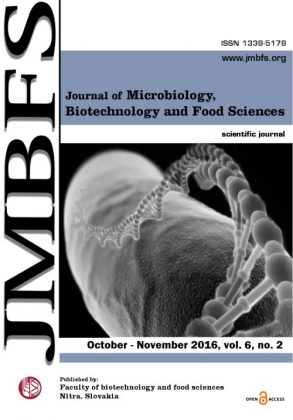EXTRACELLULAR PECTINASE ACTIVITY FROM Bacillus Cereus GC Subgroup A: ISOLATION, PRODUCTION, OPTIMIZATION AND PARTIAL CHARACTERISATION
DOI:
https://doi.org/10.15414/jmbfs.2016.6.2.767-772Keywords:
Pectinase, Bacillus Cereus, Fame-GC analysis, Amino acid compositionAbstract
A pectin degrading bacterium was isolated from a soil and identified as Bacillus cereus GC subgroup A based on its morphological, physiochemical and FAME-GC analysis. The Solid state fermentation at 37 °C for 72h, strain produced pectinase in different substrates; among the substrates orange peel powder and wheat bran powder were good for strain but mixture of orange peel powder and wheat bran powder enhanced enzyme production upto 804 IU/ml. The maximum pectinase production was studied at 370 C and pH 7 after 96h of incubation by Bacillus cereus. Regarding carbon sources, galactose (0.02%) was the best source for strain; while malt extract (0.1%) was found as the best nitrogen source for Bacillus cereus. The enzyme was partially purified by ammonium sulphate precipitation and dialysis was carried out to remove the excess salt. A Lineweaver-Burk analysis showed a Km value of 8.3 mg/ml and Vmax of 1428.5 IU/ml. The partially purified enzyme exhibited maximal activity at a temperature of 40°C and pH 6.0. The enzyme showed stability towards salts at different concentrations 1mM, 10mM, 50mM and 100mM. In addition to that CaCl2 has increased activity of enzyme at higher concentration too. The amino acid composition of pectinase was also determined by BIOEDIT software. The molecular weight of pectinase was 38304.27 Da (348 amino acids) and was rich in glycine and valine.Downloads
Download data is not yet available.
Downloads
Published
2016-10-03
How to Cite
Gophanea, S. R. ., C.N., K., & Jayebhayea, S. G. (2016). EXTRACELLULAR PECTINASE ACTIVITY FROM Bacillus Cereus GC Subgroup A: ISOLATION, PRODUCTION, OPTIMIZATION AND PARTIAL CHARACTERISATION. Journal of Microbiology, Biotechnology and Food Sciences, 6(2), 767–772. https://doi.org/10.15414/jmbfs.2016.6.2.767-772
Issue
Section
Microbiology
License
Copyright (c) 2016 Shweta R Gophanea, C.N.Khobragadea, Shilpa G Jayebhayea

This work is licensed under a Creative Commons Attribution 4.0 International License.
All papers published in the Journal of Microbiology, Biotechnology and Food Sciences are published under a CC-BY licence (CC-BY 4.0). Published materials can be shared (copy and redistribute the material in any medium or format) and adapted (remix, transform, and build upon the material for any purpose, even commercially) with specifying the author(s).





